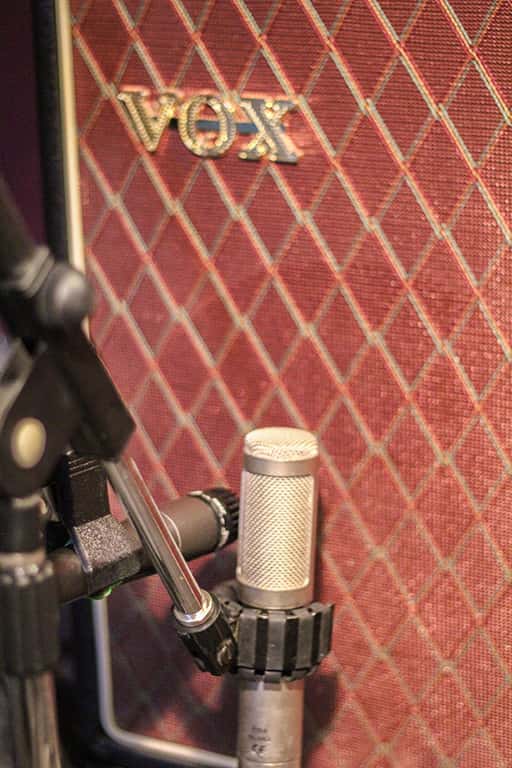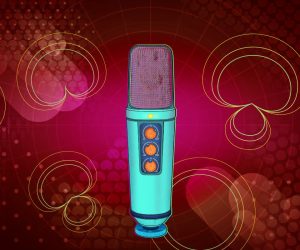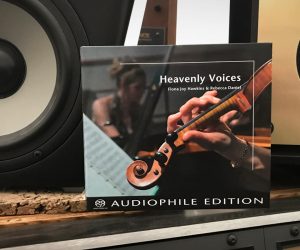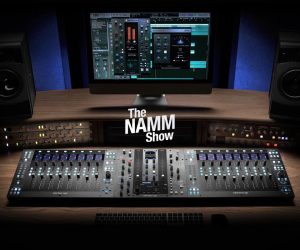
How To: Resonate With Guitar Recording, Part 2
From acoustic to electric guitars and everything in between, this tutorial will get you comfortable recording anything in the chordophone family.
Conceptualisation is just as important with electrics as it is with an acoustic track. There’s simply a bigger arsenal: guitars, pedal boards and amplifiers, both real and virtual. The tonal combinations a good guitarist can access is astounding.
GEARING UP
When I’m called in to do sessions, there are some default colours I need to have covered. For an album project, it wouldn’t be unusual to take at least six guitars. Remember, the actual guitar is your first physical point of creative connection with the part you’re about to play. If an instrument inspires you to play in a way that suits your production aesthetic, you are truly halfway there.
To cover the bases for an album recording project, I would usually take the following:
- A guitar with humbuckers for thicker tones — perhaps a Les Paul or SG.
- A guitar with single coil pickups — usually a Telecaster.
- Something in between — either a Grestch or something with P90 pickups.
- One or two ‘specialty guitars’ — a 12-string, or a guitar with a higher action for slide playing.
- A guitar with a weird combinations of pickups — my current favourites are Goldfoil pickups; or a specific tone — like a Rickenbacker.
- A B-Bender if I’m doing a country song that requires it.
Even though guitarists often agonise over their pedal boards, if you’re a producer/engineer it’s worth having a few trustworthy basics on hand. A couple of different overdrive/distortion options, and a delay and tremolo can regularly get you out of a bind. Do some research into the boxes that regularly appear on good guitarist’s boards, and invest in your own board. It can save a situation when the guitarist is struggling to nail his own combination.
It’s a similar story with amps. Once upon a time you needed to have a few amps around to cover as many bases as possible. These days, I have a couple of amps, but also know my way around amp simulators. If you’re struggling to get the tone you want from your amp, plug in a DI to stop the session from stagnating and get a ‘placeholder’ sound that you can refine within your DAW or re-amp when the pressure’s off. A lot of guitar players are still on the fence about the validity of amp simulators, but they’re pretty good these days, and rather than being in a situation where you have to choose between one or the other, embrace both worlds and make them work for you in the creative environment.
Top Tip: There’s a lot of electric guitar gear to choose from, so if you’re a producer, make sure you have the basics well covered, including handy virtual options.

GUITAR AMPS: IS SIZE EVERYTHING?
Once upon a time, it was assumed the only way to get a big sound in the studio was through a big amp turned up loud. But as guitar recording has evolved, so has our approach to amp size. The ‘secret’ to recording any guitar amp is to find its ‘sweetspot’ — the point where it is being pushed in its circuitry hard enough to sound big and full. Below this point volume-wise, the amp is being under worked, which is rarely the sound you want. Beyond the magic gain area, the amp goes in to a form of distress, which may be exactly what you want.
While I don’t have any issue with louder amps, an amp with a moderate output will generally do the trick in the studio. Getting a 30-50W amp into its sweet spot will usually give you what you need. A lot of guitarists and engineers find smaller amps more manageable in the studio; you can get the right gain level without ear-bleeding volume issues.
Not all amps sound the same. Here’s a small list of a few iconic examples of popular guitar amps and their users:
Vox AC30 – The Beatles, Brian May, The Edge.
Fender Dual Showman, Deluxe, Twin – Keith Richards, James Burton, Mike Bloomfield, Pete Townshend, Neil Young.
Marshall – Angus Young, Billy Joe Armstrong, Eddie Van Halen.
Top Tip: Get to know the level where your amp is happiest and record that!
MIC IT UP
Assuming we’re plugging into our amps and we have our first killer sound coming out of our cabinet, it’s time to put some mics up and get recording. I know one main thing; if it doesn’t sound great at the source, there’s nothing an engineer can do to fix it. And if it sounds great it’s hard to mess it up! I can’t stress how important it is to make sure the sound is the right sound coming out of the amp. Don’t be scared to get down to speaker level to listen. A lot of guitarists only ever hear their amp pointing at the back of their legs. When you put a mic on the speaker cone, they often complain about the sound being too bright. So before you put any mics up, it is essential to go and listen to the guitar amp every time!
Once you have listened and made any necessary adjustments, go back and think about what you had in mind for the sound of this particular guitar part. Think about not only the tonal aspects, but also ambient aspects. Does it need to feel fleshy and tactile and close, or a bit more roomy and ambient? These desired characteristics will have a huge influence on your mic selection and positioning. Not only that, go up moderately close to the amp and just move your head around and back a bit. You’ll soon find some spots where the sound seems to have a ‘purer’ voice. I usually recommend putting a mic there, wherever that might be, regardless of whatever else you do!
Top Tip: Get your ears down to the speaker level to find the sweet spot and put a mic there.

I’ve tried many different approaches to amp miking. For a long while, I would put a single mic back a metre or so, in the spot where the sound waves of the amp have developed a bit more. The mic is usually a dynamic, but not always — it’s not unusual to use a large diaphragm condenser in this spot. If the amp sounds good, it’s a simple way to capture a realistic representation. The other technique I’ve been using is to combine two very different tonal mics together reasonably close to the speaker cabinet. It always involves one ribbon mic, which is usually a little duller, pointed right at the centre of the speaker, in combination with another more ‘toppy’ mic. Usually that’s a Shure SM57, but it may also be a large diaphragm condenser, and this will be a little away from the centre of the speaker, to soften the tone a little. The critically important factor is that the diaphragms of both mics have to be at the same distance from the speaker, to maintain the phase relationship between the mics. This way you’re getting the best of each mic representing the best bits of the amp sound.
The thing I love about this technique is that, if recorded on to two tracks on a DAW, they essentially act as ‘bass and treble’ representation of the guitar sound, that you can balance appropriately against the track as your production develops. In other words, if at some point the guitar sound is a bit too gnarly, reduce the 57 and favour the ribbon mic, and vice versa if the sound is too cloudy or thick. These slight 3-5dB changes when you’re balancing the guitars against each other in the production can go a long way, without you having to reach for an equaliser!
Top Tip: Try balancing the sound of two different mics to give you the right blend, rather than reaching for an EQ.
Lastly, you might want to consider a ‘room mic’. Often I record guitar amps in our vocal booth, so there’s usually some sort of vocal mic already plugged in, going to a preamp and compressor. When I need a guitar sound to have a little more ‘air’ I’ll open up that channel onto another track. Sometimes it can be left where it is. But other times I’ll go and point it away from the amp, put it into an omnidirectional pattern, or push it right up against the window or into a corner for some weird reflections. If you do this, always check the phase.
I use this a lot when I’m going for that Neil Young Alabama sound — often I’ll put a delay only on the ambient mic to separate it a little further from the close mics, and maybe even pan the close mics one way and the delayed room mic the other for maximum width. It can be a fun way to push your guitar sound beyond just a good sound into something really special.
Top Tip: Try adding a room mic for a bit more air. Get fancy with some delay to push it even further away.
The ‘secret’ to recording any guitar amp is to find its ‘sweet spot’ — the point where it is being pushed in its circuitry hard enough to sound big and full

EQ & COMPRESSION
If everyone has done their job right, at this point you should barely have to do anything! Bring the mics into some good preamps that you know and trust. I don’t usually EQ these mics at all, beyond possibly a hi-pass filter at between 80-110Hz. In terms of compression, my own ‘rule’ is simple — the cleaner the guitar tone the more compression you need! So for those clean funky rhythm parts, don’t be scared to get the gain reduction knobs moving as you track, and play into the sound. But for the big rock things where you’re overdriving your amp, keep the sound big and open, and let the amp breathe.
Mr Tambourine Man by The Byrds is an early example of deliberately using studio compressors to influence a guitar tone, with the sound being run into several compressors to flatten the dynamics of the playing. The moderate attack and release time, and high ratio of compression provide maximum note articulation and sustain, unheard of before on the electric guitar. It’s a masterclass in guitar compression!
Top Tip: Electric guitar recording doesn’t require much post work. But sometimes compression can create a different sense of movement.
LAYING IT DOWN
At this point, you’re largely ready to roll. With preparation like this, not much can go wrong. Just keep checking your tuning, and sit back on the groove! A lot of musicians have a tendency to push the front of the beat pretty heavily. That’s fine if that’s the vibe you’re going for. But in general, make sure they’re hearing their overdub in a good balance with the rest of the track, and remind them to listen and sit in with the existing tracks. It’ll make your tracks feel like they have more authority and confidence, and make them easier to work with.
Whatever you do, just remember to think about what you’re doing first. Then make sure your sound is happening and your guitar in tune. After all that, recording the guitar is the easy part.
















RESPONSES